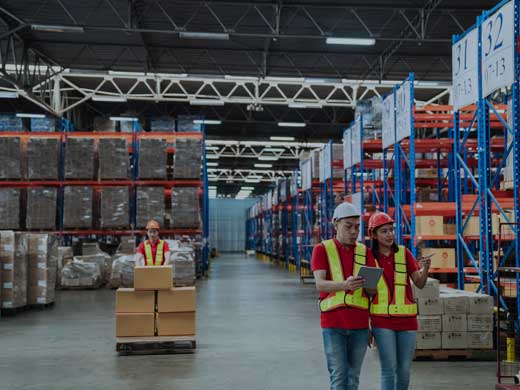Because food products have an important and direct impact on consumers' health, they are submitted to high safety requirements, which makes them prone to recalls. Recalls are not only costly, but they are also damaging to the growth and reputation of the affected company.
As international food safety regulations become more stringent, it’s essential that your business be able to comply with all relevant local regulations and show proof in the event of an audit. Here are 4 key measures that will allow you to do this. While not all consumer goods that fall out of regulation necessarily pose a risk to the public, food recalls are very often related to hazards that can have serious health consequences for consumers.
What food safety hazards can cause a product recall?

According to the Canadian Institute of Food Safety, most risks that can lead to food contamination fall into one of the following categories:
Biological contamination: This type of contamination occurs when food is contaminated with living organisms or biological material. In Canada, most foodborne illnesses are due to this type of contamination, caused mostly by bacteria or viruses, such as Salmonella or E. coli. Remember Kinder's April 2022 product recall in the country? It was linked to a salmonella outbreak that affected 150 people, mainly children.
Physical contamination: This occurs when a physical object gets into the food at any stage of the production line, which can result in a choking hazard and possibly introduce biological contaminants into the products.
Chemical contamination: This contamination is due to food contact with a chemical substance. Just this summer, batches of Häagen-Dazs ice cream were urgently recalled in many markets, including Europe, due to the detection of ethylene oxide pesticide (EtO).
Cross-contamination is the term used when contaminants of any kind are accidentally transferred from a surface or person to food. This also applies to traces of undeclared allergens that may be present in products. Be aware that this is one of the major risks associated with this type of contamination. Since 2000, cases of food allergies have multiplied and now affect 220 million people worldwide.
What are the main causes of food contamination and how to deal with them?
There are many to keep in mind. The good news is that most of them are related to operational errors, which means your company has concrete leeway to control them. Causes of contamination in the food manufacturing industry are usually due to:
- Inadequate processes
- An inability to track the product through the supply chain and in real time
- Poorly maintained product handling facilities and equipment,
- Lack of HACCP (Hazard Analysis at Critical Control Points) systems or inadequate implementation to identify, assess or control food safety hazards.
Here are 4 key preventative measures you can take to limit these errors and the risk of food contamination in your business:
1. Ensure quality control throughout the production chain

- Control ingredient safety upstream: Ensure the quality of an ingredient before it reaches your warehouse. Implementing pre-receipt controls can prevent contaminated ingredients from entering your production line.
- Avoid cross-contamination: Ensure that movement in your facilities is consistent with your food safety plan (e.g.: do not enter ready-to-eat food preparation areas with soiled kitchen towels). Also, make sure to use distinct equipment to handle raw and cooked foods or different types of foods. Handle food waste appropriately and follow strict guidelines for personal hygiene for you and your employees.
- Throughout the entire production process: Strictly define ingredient specifications to ensure the quality of everything that goes in and out of your production line. This requires setting up a procedure detailing how to handle an ingredient that falls outside of the listed specifications (e.g.: an ingredient that is rotten or arrives in a dirty or broken package).
On a similar note, be sure to maintain written documentation of your product recipes and preparation procedures to avoid duplicating or skipping a step from one batch to another (preparation time, temperature, equipment required, addition order of ingredients and their weight).
Lastly, don't forget to document product standards and rejection criteria.
- Create and enforce approval gates: Machinery and software with advanced features can help you create and enforce approval barriers (e.g.: by causing a process to stop when a problem is detected until a critical control is successfully passed).
- If your company uses ingredients with allergenic risks: Adopting a comprehensive product traceability strategy is essential and requires the full attention of staff and the implementation of well-designed procedures and systems to support them, such as Enterprise Resource Planning (ERP) software.
2. Ensure maximum visibility throughout the production chain

Without a complete traceability approach, you cannot know where your ingredients have gone or what substances they may have come in contact with. Without the ability to assess the risk of contamination, products that pose a food safety risk may not only remain in the production chain but also become difficult to identify as the source of contamination once the threat is detected.
Using an ERP built for food processing businesses can support your efforts in establishing a full-chain traceability system, from the initial supplier to the exit of your factory, allowing you to maintain full visibility of relevant operations.
By automatically capturing data throughout the supply and production chains while reporting it to your inventory, this type of software allows you to track materials and products accurately.
In addition, real time updating of all collected information minimizes the risk of errors by reducing manual data entry.
Also, remember that ERPs integrate well with smart devices such as sensors and scales, but also bar codes, QR codes, and RFID tag readers. Installed at critical points of the production line, they make it easy to monitor materials while eliminating transcription errors: ingredients and products can be tracked by lot, item number, shipment, etc.
This system not only facilitates recall management but also prevents contamination.
Lastly, it enables you to track inventory expiration dates and isolate specific components if they need to be quarantined or recalled.
Check out our article, “5 Food and Beverage KPIs that Help Increase Your Productivity and Profitability” to get the most out of your ERP software.
3. Ensure full compliance with food safety regulations

Reduce risk by monitoring equipment compliance standards, providing proper employee training and seeking out food safety certifications.
- Check on your equipment: Be sure to use the most appropriate material for your operations (e.g.: using non-absorbent materials will reduce the risk of contamination).
Similarly, cleanup is made easier by using equipment and workstations with smooth edges and rounded corners. Maintain them according to the manufacturer's standards and advice.
Also, ensure that you implement strict validation procedures and hygiene and cleaning protocols.
- Invest in your employees: Train them thoroughly. Provide them with regular, solid training on the best practices of food safety. This will make them more likely to identify and resolve problems before they escalate to a recall. Educating workers on the risks associated with food production processes will make them more attentive and willing to report non-compliance to management.
- Seek out certifications: The HACCP system is the basis of the highest food safety standards recognized by the GFSI program - Global Food Safety Initiative. Following it is an essential step in implementing such a standard and a required starting point in managing food contamination risks.
To go further, adhering to international food safety standards such as SQF, BRC, and ISO 2200 will reduce the risk of your products being recalled. The standards are designed to prevent many of the contamination causes that lead to recalls.
Also, consider implementing preventive controls. This will make food safety a daily concern throughout the company.
4. Carefully choose your suppliers and distribution partners

Standardize formal agreements with your suppliers and partners. Put your expectations in writing to ensure that they follow the same standards as you and lay down the consequences if they are not met.
Visit your suppliers' workplaces, even if it means conducting audits to ensure that they comply with their obligations. This is especially important when there is a cold chain to maintain, and you don’t have control over the facility.
One way to formalize the agreement is by implementing a Supplier Food Safety Assurance Program (SFSAP). This guide was developed by the Canadian Food Inspection Agency (CFIA) to support regulated parties in meeting the Safe Food for Canadians Regulations.
It will help you ensure that the ingredients and materials you are supplied within your food and beverage business are safe.
Food contamination is a threat to both food manufacturers and consumers. By strengthening your quality control, traceability, supplier relationships, and compliance with food safety regulations, you can help prevent a recall that can be costly and damaging to your business.
And when these recalls cannot be avoided, be aware that the best practices exist to conduct them safely and efficiently.
If you have more questions, do reach out to us.





